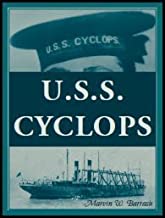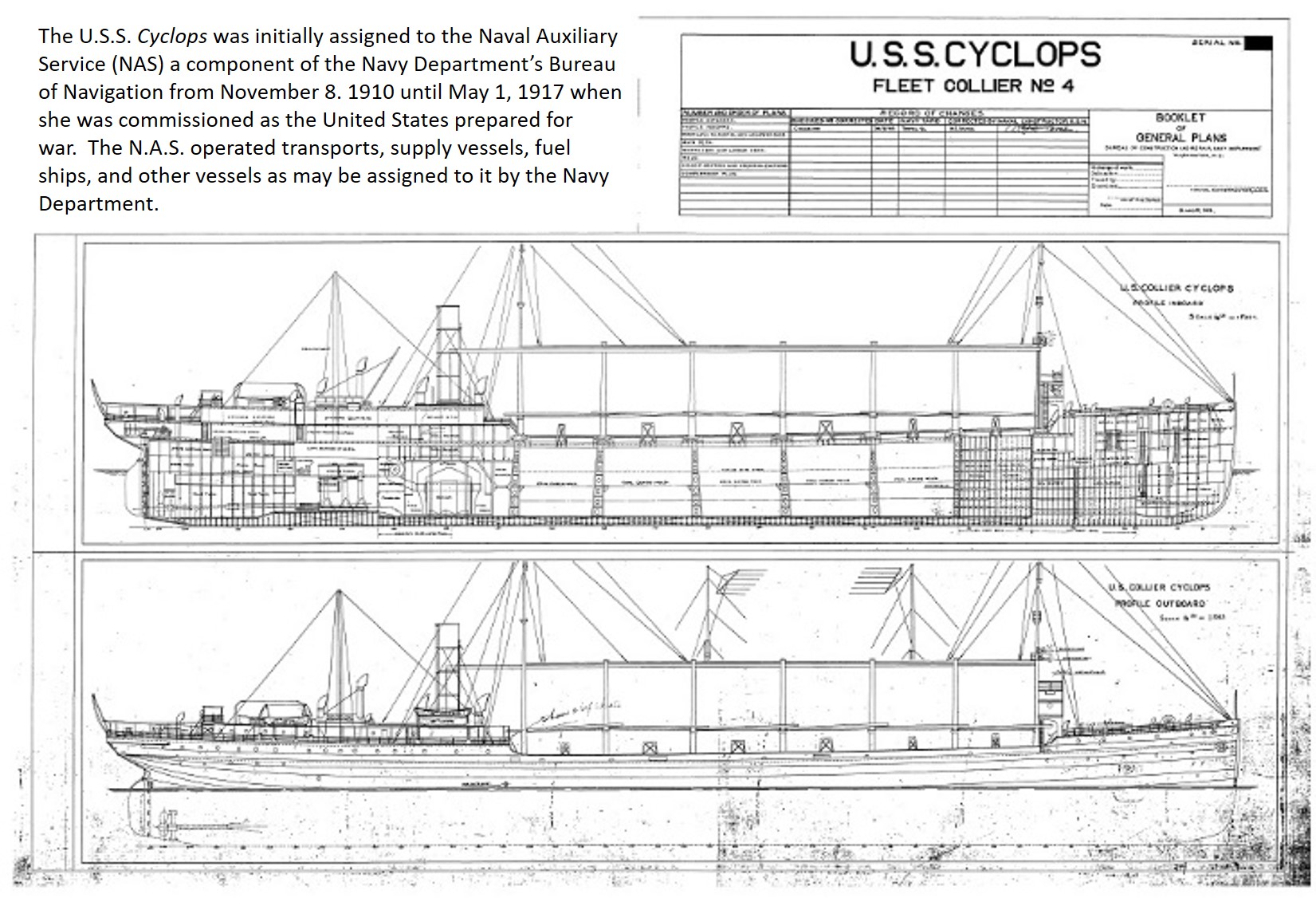A family tie to U.S. Navy ship Cyclops led to three books about the WWI mystery ship
Published: 7 February 2023
By Marvin W. Barrash
Special to the Doughboy Foundation web site

CYCLOPS-final configuration outline
I was first acquainted with the existence of the U.S. Navy ship Cyclops when I was quite young. Occasionally I would spend some time at my grandparents’ shop in Baltimore where my father worked. On many such trips to his shop, we would be pass by the War Memorial. My father would then point in its direction and mention, “My Uncle Lawrence’s name is on the wall in the War Memorial. He was lost with the collier Cyclops in the first World War.” My father was born almost ten years after his uncle, Fireman 2C, Lawrence Merkel, perished with 308 others when the U.S.S. Cyclops disappeared.

The only existing picture of Lawrence Merkel, Marvin Barrash’s great uncle, who inspired the author’s interest in the USS Cyclops, where the photo was taken. Merkel enlisted in the Navy right after President Wilson’s call for men to join up. He was one of the first 800 from Maryland to join the Navy because of a Wilson’s request. He and the others were commemorated as the Honor Boys. His name and the other 799 like him are on a 7ft tall shield shaped plaque in the foyer of the Maryland State House. It’s been there since 1917.

SS CYCLOPS Researcher and author Marvin Barrash
Several years later, a family history homework assignment inspired my interest in genealogy. Over the next several years I developed research skills and began to document my family’s past. Regrettably, I hadn’t found any information concerning my Great Uncle Lawrence until after my father’s passing. As it turned out, the path to his information was through the “collier Cyclops.”
It was at the National Archives, in Washington, D.C., that I first discovered Great Uncle Lawrence’s name in one of the Cyclops’ muster rolls. These tabloid-size crew listings were bound and kept with ship’s log books. I spent some time that day to examine the volume and made a copy of a page that included my great uncle’s name. Despite having touched something that had been on the Cyclops, I still knew nothing about the ship or her loss.
Research of the Cyclops was not a simple matter. I began to collect some shreds of information about the ship’s disappearance from several sources. At that time, I was unable to obtain one of the most important documents, a copy of my great uncle’s service record. Those files were arranged by service number and not by surname. Through a series of good contacts, I met a World War One researcher. This man, many years my senior, invited me to visit him as he investigated casualties of that war. He showed me several examples of navy service records from his collection. One of the most important results of that meeting concerned the navy’s service number.
I began to find many books that tried to make a connection between the U.S.S. Cyclops and the Bermuda Triangle. Despite the likelihood that the ship had gone down in that geographic region, I could not accept the bizarre theories presented by those authors. What I sought was a book that provided comprehensive information about the Cyclops. I knew that some serious research would be involved if I would commit myself to find out the facts concerning the ship and the 309 men aboard her when all were lost in 1918.
As I began to amass information concerning the loss of the ship, I began to realize that this subject was also in the minds of other families that lost loved ones and that there were others out there who wanted to know more about the ship’s history and what may have caused her loss. I decided that I should write the book that I had previously hoped to purchase.

Despite having taken more than a decade to research and publish the massive book, the Cyclops’ history was still incomplete. I could not find answers to some questions at that time. My research of the ship and her crew had not ceased upon the publication of the book. I remained committed to finding more information about the ship and what may have happened to her.

I was invited again to have another work published. Mr. Scott agreed that U.S.S. CYCLOPS, Volume II should be next. This third book in the trilogy included more of Captain Worley’s history as well as extensive biographical material about the men who were lost with the Cyclops. A greater number of crew and passenger photographs were included.


USS Cyclops (Fuel Ship # 4) Experimental coaling (bow to stern) at sea while under way in April 1914. Rigging between the two ships was used to transfer two 800-pound bags of coal at a time. The bags were landed on a platform in front of the battleship’s forward 12-inch gun turret, and then carried to the bunkers.
Included in U.S.S. CYCLOPS, Volume II are some never before published photographs of the Cyclops and personnel. Some of the images of the ship come from naval facilities photos. These photographs were intended to show the progress of facilities improvements, such as construction of sea walls, docks, etc., at the New York and Norfolk navy yards. Images of her fitting out after launching and during a coaling exercise at sea were also included. Images of Captain Worley, the ship and another coaling demonstration came from a motion picture that I discovered in 2018, twenty-one years after the start of my research. I had sought to find such a film at the outset this project. The film, “The Newest Method of Coaling Battleships at Sea” was a short subject filmed by the Edison Film Company on the deck of the U.S.S. Cyclops in December 1912. It was shown in theaters in February 1913. It brought to life, the operation of the collier Cyclops during an exercise involving the at-sea coaling of the battleship North Dakota at the New York Navy Yard. The film included footage of Captain Worley in his full Naval Auxiliary Service uniform as he stood next to part of the coaling mechanism. After having viewed static images and engineering drawings of the ship for many years, it was exciting to see the ship and personnel in action.
For the first time, in more than 100 years, portions of that Edison film appeared on-screen in a History Channel program in which I appeared in 2022, “The Bermuda Triangle: Into Cursed Waters”; Episode 2 “Rogue Waves.”

A USS CYCLOPS cap tally in the author’ collection. It’s the only one known to exist. It belonged to the Paymaster Carroll Goddard Page, USNRF, one among the 309 crewmembers lost with the ship.
I am very appreciative of the help that I’ve received from families whose loved ones served on the ship, Heritage Books, Inc. and personnel at research institutions including the Navy Department Library, Naval History & Heritage Command, National Archives & Records Administration, Library of Congress, Independence Seaport Museum and so many more.
My research of the U.S.S. Cyclops has not ceased despite having lived with the project since January 1997. I continue to find more about the ship, the men and information that will lead to discovery of the Cyclops’ wreckage. I hope that when the remains of the ship are found that they be studied, but not salvaged. With that discovery, the cause of the sinking could be determined. That wreckage site is a gravesite and should be preserved and respected as such.

______________________________________________________________________________



